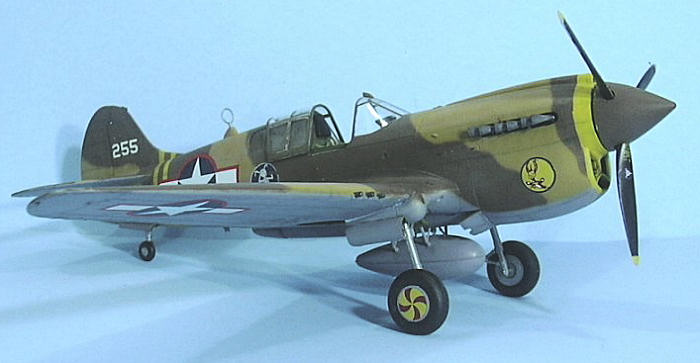
| KIT #: | 08188 |
| PRICE: | 4400 yen (about $48.00 at today's exchange rate) |
| DECALS: | Two options |
| REVIEWER: | Tom Cleaver |
| NOTES: | Limited issue |

| HISTORY |
The P-40K was a development from the P-40E, which continued use of the Allison
V-1710 engine and appeared simultaneously with the P-40F, which used the Packard
Merlin.
The P-40K used the more powerful Allison V-1710-73 (F4R) engine, with
developed 1,325 h.p., which provided increased power from the Allison V-1710-39
(F4R) with it’s 1,150 h.p. that was used by the P-40E.
The P-40E-5 had used a fin extension in an attempt to cure the directional
stability problem associated with the short fuselage inherited from the P-36.
The P-40K used this fin extension with a vertical fin
that had increased chord as well as a rudder of increased chord, to try and
solve this problem.
This was known as the “Round-Tail” P-40 due to the
change in fin and rudder.
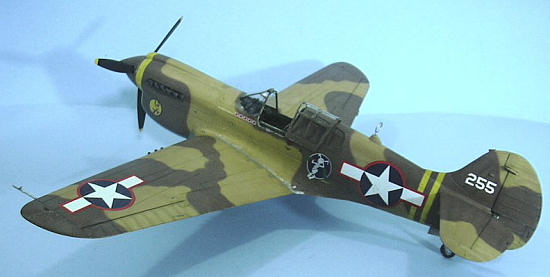 The P-40K-1 and P-40K-5 were produced with the short
fuselage and “round tail,” before production moved on to the P-40K-10, which
featured the lengthened fuselage that solved the directional stability problem
more effectively.
The P-40K-1 and P-40K-5 were produced with the short
fuselage and “round tail,” before production moved on to the P-40K-10, which
featured the lengthened fuselage that solved the directional stability problem
more effectively.
The 51st
Fighter Group:
The 51st Fighter Group was
established at Hamilton Field, California, in January 1942, consisting of the 16th,
25th and 26th
Fighter Squadrons, under the command of Major Homer L. “Tex” Sanders.
Following the attack on Pearl Harbor and the entry of
the United States into the war, the 51st
was one of three fighter groups - the others being the 49th
Fighter Group and the 35th Fighter
Group - which were alerted for transfer to the Pacific in January 1942.
It was originally planned that the groups would
reinforce the Philippines, but after they left San Francisco aboard the S.S.
“President Coolidge,” their destination was changed to Australia, where they
arrived at Melbourne on February 1, 1942.
With the war going badly, the 51st
was alerted for a movement into the combat zone, leaving Fremantle on February
23, 1942, aboard the transport USS “Holbrook” in company with the airplane
tender USS “Langley” and the freighter “Sea Witch,” which carried their P-40Es.
Their destination was Java.
On February 27, 1942, the “Langley” was sunk with all
aircraft, and the “Sea Witch” was badly damaged.
The “Holbrook” was ordered to continue on for Colombo,
Ceylon, then was re-routed to Karachi. On arrival in Karachi on March 12, the 51st
was without aircraft.
On April 22, 1942, P-40-equipped units on the U.S. East Coast were stripped of
pilots and aircraft, 68 which were put aboard the carrier USS “Ranger” in New
York harbor.
Half of the P-40s were new P-40K-1s. Among the pilots was 1st
Lt. Edward Nollmeyer, late of the 54th
Fighter Group. The “Ranger” put to sea with the Army airplanes and pilots,
headed for Africa.
On May 10, 1942, the 68 aircraft were successfully
launched at sea, headed for Accra, Guinea.
All arrived safely, and within days began an odyssey
across Africa in 6-plane groups, accompanied by B-25s for navigation.
The flight proceeded in stages, first to Lagos, Nigeria,
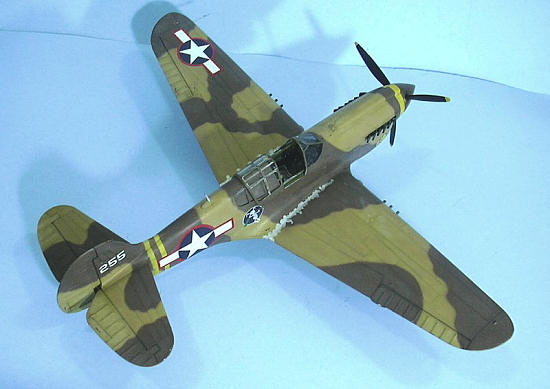 then on to Lake Chad, across to Sudan, up to Cairo, then on to Jerusalem, across
the forbidding desert to Baghdad, then on across the Strait of Hormuz to
Karachi.
62 of the aircraft made the entire trip, with six putting down in Africa
when they became lost, though all 68 pilots eventually made it to Karachi.
then on to Lake Chad, across to Sudan, up to Cairo, then on to Jerusalem, across
the forbidding desert to Baghdad, then on across the Strait of Hormuz to
Karachi.
62 of the aircraft made the entire trip, with six putting down in Africa
when they became lost, though all 68 pilots eventually made it to Karachi.
In Karachi, 32 pilots and aircraft were assigned to the new 23rd
Fighter Group, the replacement for the American Volunteer Group, and sent on to
Kunming to the China Air Task Force.
The others, including Nollmeyer, joined the 51st
Fighter Group in Karachi.
The 51st
sent the 16th Fighter Squadron on
to Kunming with the 23rd Fighter
Group.
The following week three experienced pilots were sent to Assam, to fly
recon over Burma.
In October, the 51st assumed
responsibility for air defense of the southern terminus of “the Hump” in Dinjan,
India. On October 26, 1942, 90 “Sally” bombers and “Oscar” fighters appeared
without prior warning over the base.
Colonel Sanders, the group CO, and his wingman had taken
off on a patrol and spotted the Japanese, shooting down two Oscars, while the
Japanese destroyed 3 P-40s, two P-43s and damaged 13 other P-40s.
24 hours later, the 64th Sentai
sent Oscars to strafe the base.
Among the Americans who met the attackers was 1st
Lt. Nollmeyer, who pursued one of the Ki.43s and exploded it for his first
victory.
The Japanese left the base alone after this, but the 25th
and 26th Fighter Squadrons
continued to patrol among the towering Himalayas, and branched out with strafing
attacks in Burma by the end of the year.
The Japanese began an offensive into Assam in February 1943, which brought the
51st into combat again, with a big
battle on 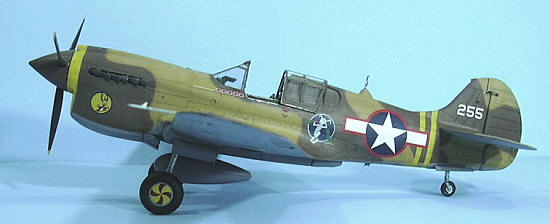 February 25, 1943, against 27 attacking Sallys with an escort of 21
Oscars, which became the unit’s best day in Assam.
Nollmeyer scored his second Oscar, one of 14 victories
claimed that day, with 13 probables.
A final victory in April 1943 over a Dinah was the
unit’s last score in India.
February 25, 1943, against 27 attacking Sallys with an escort of 21
Oscars, which became the unit’s best day in Assam.
Nollmeyer scored his second Oscar, one of 14 victories
claimed that day, with 13 probables.
A final victory in April 1943 over a Dinah was the
unit’s last score in India.
Over the summer of 1943, as other pilots completed their tours, Nollmeyer was
given command of the 25th
fighter Squadron, and then promoted to Major in September 1943.
In October 1943, after the monsoon, the 51st was transferred to the 14th Air Force in China, where they would defend the northern end of “the Hump” in Kweilin, in southern Yunnan Province. Fighting got heavy in December 1953, with the Japanese offensive against Changteh. In the raging air battles around this offensive in December, Nollmeyer scored one Ki.43 on December 18 and two Oscars on December 23, to become the first ace of the 25th FS.
| THE KIT |
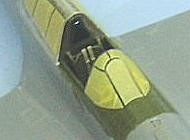
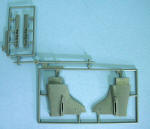 This is the second of Hasegawa’s 1/32 P-40s.
The P-40E was well received, though modelers were upset
by Hasegawa’s mistaken molding of the windscreen with two clear panels.
This was difficult to correct, but could be done.
Fortunately, Hasegawa has corrected this fault and the
new windscreen has the correct one-piece side panels.
The other change from the earlier kit is the provision
of the larger “round tail” associated with the P-40K-1 and K-5 Warhawk.
This is the second of Hasegawa’s 1/32 P-40s.
The P-40E was well received, though modelers were upset
by Hasegawa’s mistaken molding of the windscreen with two clear panels.
This was difficult to correct, but could be done.
Fortunately, Hasegawa has corrected this fault and the
new windscreen has the correct one-piece side panels.
The other change from the earlier kit is the provision
of the larger “round tail” associated with the P-40K-1 and K-5 Warhawk.
Decals are provided for the P-49K-1 flown by Major Ed Nollmeyer of the 25th Fighter Squadron, 51st Fighter Group, and a P-40K-5 flown by the 78th Fighter Squadron of the 18th Fighter Group in Hawaii.
| CONSTRUCTION |
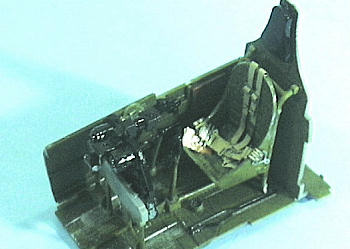 Having learned my lessons with the earlier kit, I made sure to attach the tail
parts to each forward fuselage half before proceeding to assemble the fuselage.
I needed quite a bit of cyanoacrylate glue and Mr.
Surfacer to get rid of the seam, which I then rescribed and used my pounce wheel
to replace the line of rivets with each panel line.
I had to do the same thing, very carefully, with the
rear canopy parts, which also do not attach on panel lines.
Having learned my lessons with the earlier kit, I made sure to attach the tail
parts to each forward fuselage half before proceeding to assemble the fuselage.
I needed quite a bit of cyanoacrylate glue and Mr.
Surfacer to get rid of the seam, which I then rescribed and used my pounce wheel
to replace the line of rivets with each panel line.
I had to do the same thing, very carefully, with the
rear canopy parts, which also do not attach on panel lines.
Past this, the model presented no difficulties and was assembled as I had
assembled the P-40E.
These 1/32 kits have better overall fit than the
previous 1/48 kits, which is important with the “modular” construction Hasegawa
uses to allow them to do the differing versions of the P-40.
I used Eduard seat belts to dress up the cockpit, which
was otherwise done “out of the box.”
| COLORS & MARKINGS |
Painting:
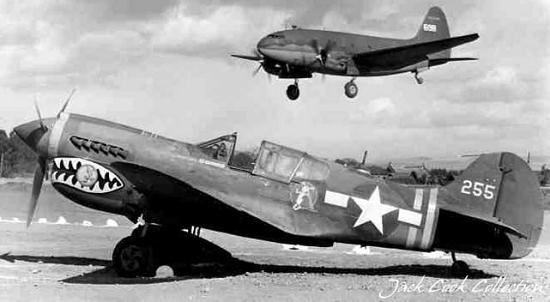 Everyone thinks they know Nollmeyer’s airplane, due to the well-known black and
white photo of the airplane taken at Chunking just before Nollmeyer finished his
tour with the 51st and returned
home in early 1944.
It’s Dark Earth and Dark Green, with Neutral Grey
undersides, right?
Everyone thinks they know Nollmeyer’s airplane, due to the well-known black and
white photo of the airplane taken at Chunking just before Nollmeyer finished his
tour with the 51st and returned
home in early 1944.
It’s Dark Earth and Dark Green, with Neutral Grey
undersides, right?
Maybe.
While I was researching the project, I found this color photograph of
Nollmeyer’s P-40K - it can be identified as such by the two yellow stripes
signifying his status as Squadron CO on the rear fuselage.
Because of the Squadron CO markings, it can be dated as
sometime after September, 1943, but before early November, 1943, when the
“China’s Blitzer” reindeer insignia for the 25th
FS was put on the radiator cowling.
The “255" on the rudder definitely identifies the
airplane as Nollmeyer’s, since the 200-255 series of theater markings in China
were assigned to the 25th FS in
October 1943.
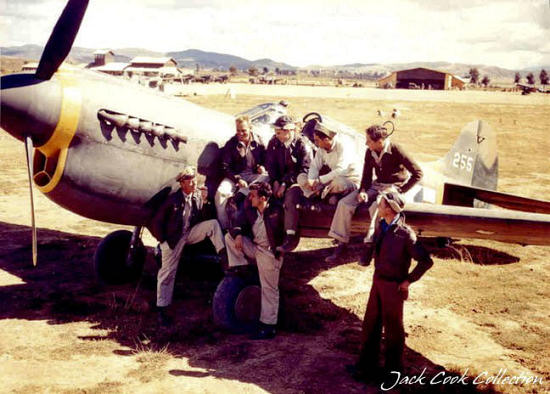 The problem is that the airplane appears to be pretty obviously painted in Dark
Earth and the US version of “Middle Stone,” not Dark Earth and Dark Green.
I researched the daylights out of this, thinking that
these were sun-faded versions of Dark Earth and Dark Green, but I am pretty
certain they are the desert colors.
The problem is that the airplane appears to be pretty obviously painted in Dark
Earth and the US version of “Middle Stone,” not Dark Earth and Dark Green.
I researched the daylights out of this, thinking that
these were sun-faded versions of Dark Earth and Dark Green, but I am pretty
certain they are the desert colors.
How could this be?
Well, in the Spring of 1942, when the Army decided to
send the P-40 reinforcements to India and China, the decision was made in a
hurry.
According to an account by one of the pilots who flew the mission, they
went to Curtiss in Buffalo and picked up new P-40s just before being put aboard
the “Ranger.”
At the time, Curtiss was producing P-40Ks for the RAF as
Kittyhawk IIIs, which were all destined for North Africa and by 1942 would have
been painted in the British “desert colors.”
I think at the time, no one was worrying whether they
were picking up “American” P-40s or “British” P-40s, and it could have easily
been the case that a desert-camo Kittyhawk III could have been in the mix.
Interestingly enough, I did photograph my model after I
completed it, and turned the color photo to black and white, where I was able to
manipulate the grey tones to something pretty similar to the grey tones in the
more well-known photo.
So, can I prove without a doubt that everyone else has been wrong for 60+ years
in their color call-outs for this airplane.
No, but I can certainly point to numerous e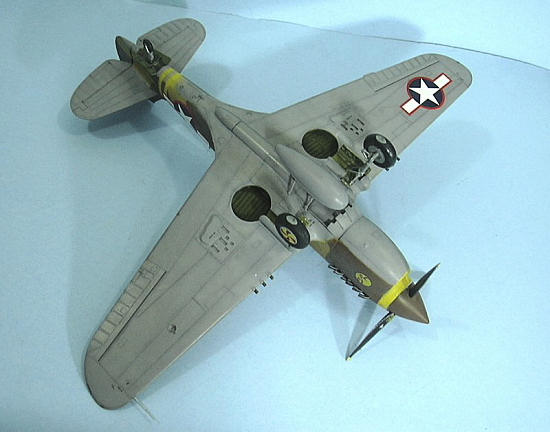 xamples (the
“all white” Sea Hurricanes of 825 Squadron come to mind) where “color gurus”
have made calls that have been followed by others until the call is considered
“fact,” only to have someone come along, take a second look at the relevant
pictures, and demonstrate that the original “facts” are more fantasy than fact.
Besides, I already have a Dark Green/Dark Earth P-40E on
the shelf.
xamples (the
“all white” Sea Hurricanes of 825 Squadron come to mind) where “color gurus”
have made calls that have been followed by others until the call is considered
“fact,” only to have someone come along, take a second look at the relevant
pictures, and demonstrate that the original “facts” are more fantasy than fact.
Besides, I already have a Dark Green/Dark Earth P-40E on
the shelf.
At any rate, the model was painted with Xtracrylix Dark Earth, Tamiya “Desert
Yellow” (since I was going for the “US equivalent” which is known to be a
different shade from the official RAF color), and Gunze-Sangyo “Neutral Grey,”
with the camouflage all done freehand and then sun-faded after being
“pre-shaded” for color depth.
Decals:
Studying the photos, I am also convinced that the large insignia Hasegawa says should be on the fuselage is too big. I went into the Decal Dungeon and found some red-surround insignia that are the correct size, which I used for the national markings. The rest of the markings all come from the kit sheet. I note that these decals are particularly thin. I managed to screw up the “255" from the kit, and replaced it with numbers from a sheet in the dungeon. Again, these numbers, which are smaller than those supplied in the kit decals, appear to be more correct when I “eyeball” the completed model and compare it with the photos.
| FINAL CONSTRUCTION |
After giving the model a flat finish by adding in some Tamiya “Flat Base” to the
Xtracrylix Flat varnish, I applied some exhaust staining and oil stains on the
lower fuselage with Tamiya “Smoke”, then attached landing gear, drop tank,
exhaust stacks, wheels and prop, and unmasked the canopy.
I attached the sliding canopy in the open position.
| CONCLUSIONS |
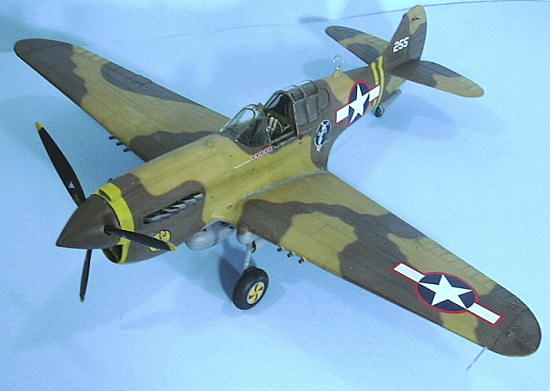 Hasegawa “owns” P-40s in 1/32 scale now, the way they “own” the airplane in 1/48
scale.
I personally like the “round tail” P-40K the best of the “short” P-40s,
and like this kit very well.
It’s one of Hasegawa’s limited release kits and now out
of production.
Currently, HLJ, Squadron, Hannant’s, Roll Models, and Sprue
Brothers do not have this kit in stock, so it looks like if you didn’t order it
when first released in October, you may be too late until Hasegawa releases it
again.
Hasegawa “owns” P-40s in 1/32 scale now, the way they “own” the airplane in 1/48
scale.
I personally like the “round tail” P-40K the best of the “short” P-40s,
and like this kit very well.
It’s one of Hasegawa’s limited release kits and now out
of production.
Currently, HLJ, Squadron, Hannant’s, Roll Models, and Sprue
Brothers do not have this kit in stock, so it looks like if you didn’t order it
when first released in October, you may be too late until Hasegawa releases it
again.
Review Kit courtesy of HobbyLink Japan.
December 2008
If you would like your product reviewed fairly and quickly, please contact me or see other details in the Note to Contributors.